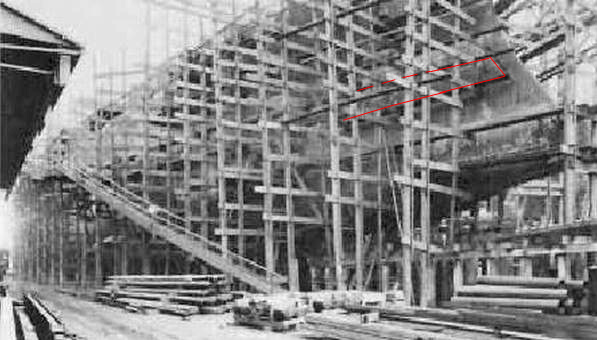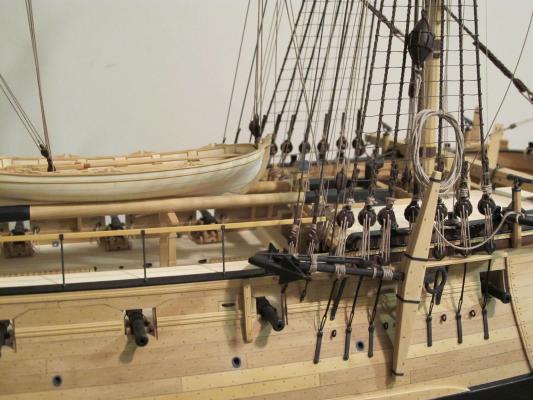-
Posts
13,278 -
Joined
-
Last visited
Content Type
Profiles
Forums
Gallery
Events
Everything posted by druxey
-
Ah, well, it's pennant penance for you next time, John. Don't you just hate when that happens? Think twice, cut once.... My sympathy. The model looks great, BTW.
-
Very nice work, Toni. I suspect that there were 'filler' pieces above the doors that need to be short for privacy and or security.
- 1,449 replies
-
Nice to see your progress, Gary. It always brings a smile to my face when seeing your work. Excellent!
-
If port sills were all horizontal and not parallel to the deck sheer then the planking of each inside would need to be chiselled out square. In addition, the curve of the ship's sides prevents port lids from being interchangeable. You could ask why a ship has sheer and is not flat along the decks. Sheer is required to counteract the tendency for the (wooden) structure to sag and for drainage. A ship is very unlike the architecture of a building, where all items are at right angles, parallel and eight horizontal or vertical, modern day cruise ships excepted!
-
Is there no stopping you and this navy of 1:36 scale models? I wonder if anyone else is turning out models at this scale. Nice start, Jerry.
- 97 replies
-
- macedonian
- frigate
-
(and 2 more)
Tagged with:
-
Unfortunately this is the weakness of kit-supplied planking strips. If you can get a fine-grained veneer from a local source (I assume you don't have the power tools to machine your own plank sheet 'blanks'), you might consider that route. Spiling is definitely the way to go if you want the nice planking look of scratch-built models.
-

HMS Naiad 1797 by albert - FINISHED - 1/48
druxey replied to albert's topic in - Build logs for subjects built 1751 - 1800
This is where things start to get interesting! -

HMS Naiad 1797 by albert - FINISHED - 1/48
druxey replied to albert's topic in - Build logs for subjects built 1751 - 1800
Now that is a brilliant beginning, Albert! -
Those catheads are tough beasts to wrestle, but it looks like you've won, despite the battle damage!
-

Protecting Copper
druxey replied to Patrick Haw's topic in Building, Framing, Planking and plating a ships hull and deck
If you absolutely want a shiny copper bottom, you will need to be very careful not to pull up plate edges while cleaning them. This is virtually impossible! However, if you are successful, you will also need to swab the copper with acetone to remove any trace of grease before spraying with lacquer as suggested. Otherwise your fingerprints will come back to haunt you! -
The 'under construction' photo appears to show the fore end of an armour belt with the fore end angled to match the curve of the stem.
- 116 replies
-
- kilkis
- mississippi
-
(and 2 more)
Tagged with:
-

Cruizer-class Brig-Sloops of the Royal Navy
druxey replied to molasses's topic in Nautical/Naval History
Michael: you mention the Waite/Tucker 'Select List' mini-volume. You might be interested to know that prior to that, there were many sheets of bond paper with mimeographed(!) typewritten list of plans by rating that those gentlemen had assembled. These lists were comprehensive. My copies of some of those lists fell to pieces years ago, alas. They would be very useful, other than the catalog numbers were the old Admiralty Box/Sheet system rather than the ZAZ numbers used today. -

Standing rigging color preference and historical musings
druxey replied to Chuck's topic in Masting, rigging and sails
-

ancre Le Fleuron by cabrapente - FINISHED
druxey replied to cabrapente's topic in - Build logs for subjects built 1501 - 1750
Very authentic looking galley kitchen! Nicely done, Cabrapente.- 332 replies
-
- le fleuron
- 64 gun
-
(and 1 more)
Tagged with:
-
Dear E&T, The draughts you mention are exactly the ones I was thinking of. Unfortunately, I know no more than you on that subject. Perhaps another reader might be knowledgeable about the point you raise. Your research and drafting is very impressive. Looking forward to further installments!
- 346 replies
-
- terror
- polar exploration
-
(and 2 more)
Tagged with:
-
Many ships from about 1810 on had diagonal deck planking. There are a number of deck plans c.1810-15 in the NMM collection showing this form of construction. I suspect Seppings may have played a role in this (then) innovation.
- 346 replies
-
- terror
- polar exploration
-
(and 2 more)
Tagged with:
-

Making small nails with round head
druxey replied to Aleksei Domanov's topic in Metal Work, Soldering and Metal Fittings
Nice technique, Alexey. Thank you for sharing this neat method. -
Jaxboat: I've used Fiebing's dye - both brown and black - for some years now, with no apparent fading. Of course, the models are never exposed to direct sunlight.
-
And effective. Great idea, Dave.
About us
Modelshipworld - Advancing Ship Modeling through Research
SSL Secured
Your security is important for us so this Website is SSL-Secured
NRG Mailing Address
Nautical Research Guild
237 South Lincoln Street
Westmont IL, 60559-1917
Model Ship World ® and the MSW logo are Registered Trademarks, and belong to the Nautical Research Guild (United States Patent and Trademark Office: No. 6,929,264 & No. 6,929,274, registered Dec. 20, 2022)
Helpful Links
About the NRG
If you enjoy building ship models that are historically accurate as well as beautiful, then The Nautical Research Guild (NRG) is just right for you.
The Guild is a non-profit educational organization whose mission is to “Advance Ship Modeling Through Research”. We provide support to our members in their efforts to raise the quality of their model ships.
The Nautical Research Guild has published our world-renowned quarterly magazine, The Nautical Research Journal, since 1955. The pages of the Journal are full of articles by accomplished ship modelers who show you how they create those exquisite details on their models, and by maritime historians who show you the correct details to build. The Journal is available in both print and digital editions. Go to the NRG web site (www.thenrg.org) to download a complimentary digital copy of the Journal. The NRG also publishes plan sets, books and compilations of back issues of the Journal and the former Ships in Scale and Model Ship Builder magazines.




